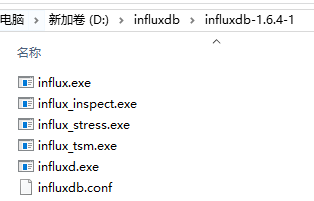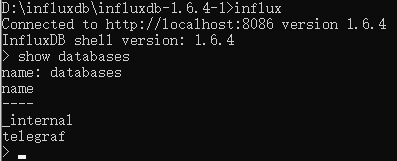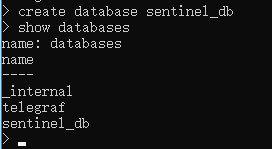sentinel控制台监控数据持久化【InfluxDB】
根据官方wiki文档,sentinel控制台的实时监控数据,默认仅存储 5 分钟以内的数据。如需持久化,需要定制实现相关接口。
https://github.com/alibaba/Sentinel/wiki/在生产环境中使用-Sentinel-控制台 也给出了指导步骤:
1.自行扩展实现 MetricsRepository 接口;
2.注册成 Spring Bean 并在相应位置通过 @Qualifier 注解指定对应的 bean name 即可。
本文使用时序数据库InfluxDB来进行持久化,从下载开始,一步步编写一个基于InfluxDB的存储实现。
-----------------------------------------------------------------------------------------------------------------------------------------------------------------------------------------
InfluxDB官网:https://www.influxdata.com
关键词:
高性能时序数据库
go语言编写没有外部依赖
支持HTTP API读写
支持类SQL查询语法
通过数据保留策略(Retention Policies)支持自动清理历史数据
通过连续查询(Continuous Queries)支持数据归档
最新版本:1.6.4
下载
windows:wget https://dl.influxdata.com/influxdb/releases/influxdb-1.6.4_windows_amd64.zip
linux:wget https://dl.influxdata.com/influxdb/releases/influxdb-1.6.4_linux_amd64.tar.gz
注:windows下载安装wget https://eternallybored.org/misc/wget/
在windows环境,解压zip文件至D:\influxdb\influxdb-1.6.4-1目录:

打开cmd命令行窗口,在D:\influxdb\influxdb-1.6.4-1执行命令启动influxdb服务端:influxd

再打开一个cmd窗口,在目录下输入influx启动客户端: // 后面可以带上参数:-precision rfc3339 指定时间格式显示

show databases发现只有系统的2个数据库,这里我们新建一个sentinel_db,输入命令:create database sentinel_db

use sentinel_db 使用sentinel_db数据库
show measurements 查看数据库中的数据表(measurement)

可以看到,这几个InfluxDB命令跟MySQL很相似。
==============================================================
InfluxDB名词概念:
database:数据库 // 关系数据库的database
measurement:数据库中的表 // 关系数据库中的table
point:表里的一行数据 // 关系数据库中的row
point由3部分组成:
time:每条数据记录的时间,也是数据库自动生成的主索引;// 类似主键
fields:各种记录的值;// 没有索引的字段
tags:各种有索引的属性 // 有索引的字段
==============================================================
在官方github上,有一个java的客户端库:
https://github.com/influxdata/influxdb-java
在sentinel-dashboard的pom.xml中,加入maven依赖:
<dependency>
<groupId>org.influxdb</groupId>
<artifactId>influxdb-java</artifactId>
<version>2.14</version>
</dependency>
封装一个工具类:存储InfluxDB连接信息以及方便调用
/**
* @author cdfive
* @date 2018-10-19
*/
@Component
public class InfluxDBUtils { private static Logger logger = LoggerFactory.getLogger(InfluxDBUtils.class); private static String url; private static String username; private static String password; private static InfluxDBResultMapper resultMapper = new InfluxDBResultMapper(); @Value("${influxdb.url}")
public void setUrl(String url) {
InfluxDBUtils.url = url;
} @Value("${influxdb.username}")
public void setUsername(String username) {
InfluxDBUtils.username = username;
} @Value("${influxdb.password}")
public void setPassword(String password) {
InfluxDBUtils.password = password;
} public static void init(String url, String username, String password) {
InfluxDBUtils.url = url;
InfluxDBUtils.username = username;
InfluxDBUtils.password = password;
} public static <T> T process(String database, InfluxDBCallback callback) {
InfluxDB influxDB = null;
T t = null;
try {
influxDB = InfluxDBFactory.connect(url, username, password);
influxDB.setDatabase(database); t = callback.doCallBack(database, influxDB);
} catch (Exception e) {
logger.error("[process exception]", e);
} finally {
if (influxDB != null) {
try {
influxDB.close();
} catch (Exception e) {
logger.error("[influxDB.close exception]", e);
}
}
} return t;
} public static void insert(String database, InfluxDBInsertCallback influxDBInsertCallback) {
process(database, new InfluxDBCallback() {
@Override
public <T> T doCallBack(String database, InfluxDB influxDB) {
influxDBInsertCallback.doCallBack(database, influxDB);
return null;
}
}); } public static QueryResult query(String database, InfluxDBQueryCallback influxDBQueryCallback) {
return process(database, new InfluxDBCallback() {
@Override
public <T> T doCallBack(String database, InfluxDB influxDB) {
QueryResult queryResult = influxDBQueryCallback.doCallBack(database, influxDB);
return (T) queryResult;
}
});
} public static <T> List<T> queryList(String database, String sql, Map<String, Object> paramMap, Class<T> clasz) {
QueryResult queryResult = query(database, new InfluxDBQueryCallback() {
@Override
public QueryResult doCallBack(String database, InfluxDB influxDB) {
BoundParameterQuery.QueryBuilder queryBuilder = BoundParameterQuery.QueryBuilder.newQuery(sql);
queryBuilder.forDatabase(database); if (paramMap != null && paramMap.size() > 0) {
Set<Map.Entry<String, Object>> entries = paramMap.entrySet();
for (Map.Entry<String, Object> entry : entries) {
queryBuilder.bind(entry.getKey(), entry.getValue());
}
} return influxDB.query(queryBuilder.create());
}
}); return resultMapper.toPOJO(queryResult, clasz);
} public interface InfluxDBCallback {
<T> T doCallBack(String database, InfluxDB influxDB);
} public interface InfluxDBInsertCallback {
void doCallBack(String database, InfluxDB influxDB);
} public interface InfluxDBQueryCallback {
QueryResult doCallBack(String database, InfluxDB influxDB);
}
}
其中:
url、username、password用于存储InfluxDB的连接、用户名、密码信息,定义为static属性,因此在set方法上使用@Value注解从配置文件读取属性值;
resultMapper用于查询结果到实体类的映射;
init方法用于初始化url、username、password;
process为通用的处理方法,负责打开关闭连接,并且调用InfluxDBCallback回调方法;
insert为插入数据方法,配合InfluxDBInsertCallback回调使用;
query为通用的查询方法,配合InfluxDBQueryCallback回调方法使用,返回QueryResult对象;
queryList为查询列表方法,调用query得到QueryResult,再通过resultMapper转换为List<实体类>;
在resources目录下的application.properties文件中,增加InfluxDB的配置:
influxdb.url=${influxdb.url}
influxdb.username=${influxdb.username}
influxdb.password=${influxdb.password}
用${xxx}占位符,这样可以通过maven的pom.xml添加profile配置不同环境(开发、测试、生产) 或 从配置中心读取参数。
在datasource.entity包下,新建influxdb包,下面新建sentinel_metric数据表(measurement)对应的实体类MetricPO:
package com.taobao.csp.sentinel.dashboard.datasource.entity.influxdb; import org.influxdb.annotation.Column;
import org.influxdb.annotation.Measurement; import java.time.Instant; /**
* @author cdfive
* @date 2018-10-19
*/
@Measurement(name = "sentinel_metric")
public class MetricPO { @Column(name = "time")
private Instant time; @Column(name = "id")
private Long id; @Column(name = "gmtCreate")
private Long gmtCreate; @Column(name = "gmtModified")
private Long gmtModified; @Column(name = "app", tag = true)
private String app; @Column(name = "resource", tag = true)
private String resource; @Column(name = "passQps")
private Long passQps; @Column(name = "successQps")
private Long successQps; @Column(name = "blockQps")
private Long blockQps; @Column(name = "exceptionQps")
private Long exceptionQps; @Column(name = "rt")
private double rt; @Column(name = "count")
private int count; @Column(name = "resourceCode")
private int resourceCode; // getter setter省略
}
该类参考MetricEntity创建,加上influxdb-java包提供的注解,通过@Measurement(name = "sentinel_metric")指定数据表(measurement)名称,
time作为时序数据库的时间列;
app、resource设置为tag列,通过注解标识为tag=true;
其它字段为filed列;
接着在InMemoryMetricsRepository所在的repository.metric包下新建InfluxDBMetricsRepository类,实现MetricsRepository<MetricEntity>接口:
package com.taobao.csp.sentinel.dashboard.repository.metric; import com.alibaba.csp.sentinel.util.StringUtil;
import com.taobao.csp.sentinel.dashboard.datasource.entity.MetricEntity;
import com.taobao.csp.sentinel.dashboard.datasource.entity.influxdb.MetricPO;
import com.taobao.csp.sentinel.dashboard.util.InfluxDBUtils;
import org.apache.commons.lang.time.DateFormatUtils;
import org.apache.commons.lang.time.DateUtils;
import org.influxdb.InfluxDB;
import org.influxdb.dto.Point;
import org.springframework.stereotype.Repository;
import org.springframework.util.CollectionUtils; import java.util.*;
import java.util.concurrent.TimeUnit;
import java.util.stream.Collectors; /**
* metrics数据InfluxDB存储实现
* @author cdfive
* @date 2018-10-19
*/
@Repository("influxDBMetricsRepository")
public class InfluxDBMetricsRepository implements MetricsRepository<MetricEntity> { /**时间格式*/
private static final String DATE_FORMAT_PATTERN = "yyyy-MM-dd HH:mm:ss.SSS"; /**数据库名称*/
private static final String SENTINEL_DATABASE = "sentinel_db"; /**数据表名称*/
private static final String METRIC_MEASUREMENT = "sentinel_metric"; /**北京时间领先UTC时间8小时 UTC: Universal Time Coordinated,世界统一时间*/
private static final Integer UTC_8 = 8; @Override
public void save(MetricEntity metric) {
if (metric == null || StringUtil.isBlank(metric.getApp())) {
return;
} InfluxDBUtils.insert(SENTINEL_DATABASE, new InfluxDBUtils.InfluxDBInsertCallback() {
@Override
public void doCallBack(String database, InfluxDB influxDB) {
if (metric.getId() == null) {
metric.setId(System.currentTimeMillis());
}
doSave(influxDB, metric);
}
});
} @Override
public void saveAll(Iterable<MetricEntity> metrics) {
if (metrics == null) {
return;
} Iterator<MetricEntity> iterator = metrics.iterator();
boolean next = iterator.hasNext();
if (!next) {
return;
} InfluxDBUtils.insert(SENTINEL_DATABASE, new InfluxDBUtils.InfluxDBInsertCallback() {
@Override
public void doCallBack(String database, InfluxDB influxDB) {
while (iterator.hasNext()) {
MetricEntity metric = iterator.next();
if (metric.getId() == null) {
metric.setId(System.currentTimeMillis());
}
doSave(influxDB, metric);
}
}
});
} @Override
public List<MetricEntity> queryByAppAndResourceBetween(String app, String resource, long startTime, long endTime) {
List<MetricEntity> results = new ArrayList<MetricEntity>();
if (StringUtil.isBlank(app)) {
return results;
} if (StringUtil.isBlank(resource)) {
return results;
} StringBuilder sql = new StringBuilder();
sql.append("SELECT * FROM " + METRIC_MEASUREMENT);
sql.append(" WHERE app=$app");
sql.append(" AND resource=$resource");
sql.append(" AND time>=$startTime");
sql.append(" AND time<=$endTime"); Map<String, Object> paramMap = new HashMap<String, Object>();
paramMap.put("app", app);
paramMap.put("resource", resource);
paramMap.put("startTime", DateFormatUtils.format(new Date(startTime), DATE_FORMAT_PATTERN));
paramMap.put("endTime", DateFormatUtils.format(new Date(endTime), DATE_FORMAT_PATTERN)); List<MetricPO> metricPOS = InfluxDBUtils.queryList(SENTINEL_DATABASE, sql.toString(), paramMap, MetricPO.class); if (CollectionUtils.isEmpty(metricPOS)) {
return results;
} for (MetricPO metricPO : metricPOS) {
results.add(convertToMetricEntity(metricPO));
} return results;
} @Override
public List<String> listResourcesOfApp(String app) {
List<String> results = new ArrayList<>();
if (StringUtil.isBlank(app)) {
return results;
} StringBuilder sql = new StringBuilder();
sql.append("SELECT * FROM " + METRIC_MEASUREMENT);
sql.append(" WHERE app=$app");
sql.append(" AND time>=$startTime"); Map<String, Object> paramMap = new HashMap<String, Object>();
long startTime = System.currentTimeMillis() - 1000 * 60;
paramMap.put("app", app);
paramMap.put("startTime", DateFormatUtils.format(new Date(startTime), DATE_FORMAT_PATTERN)); List<MetricPO> metricPOS = InfluxDBUtils.queryList(SENTINEL_DATABASE, sql.toString(), paramMap, MetricPO.class); if (CollectionUtils.isEmpty(metricPOS)) {
return results;
} List<MetricEntity> metricEntities = new ArrayList<MetricEntity>();
for (MetricPO metricPO : metricPOS) {
metricEntities.add(convertToMetricEntity(metricPO));
} Map<String, MetricEntity> resourceCount = new HashMap<>(32); for (MetricEntity metricEntity : metricEntities) {
String resource = metricEntity.getResource();
if (resourceCount.containsKey(resource)) {
MetricEntity oldEntity = resourceCount.get(resource);
oldEntity.addPassQps(metricEntity.getPassQps());
oldEntity.addRtAndSuccessQps(metricEntity.getRt(), metricEntity.getSuccessQps());
oldEntity.addBlockQps(metricEntity.getBlockQps());
oldEntity.addExceptionQps(metricEntity.getExceptionQps());
oldEntity.addCount(1);
} else {
resourceCount.put(resource, MetricEntity.copyOf(metricEntity));
}
} // Order by last minute b_qps DESC.
return resourceCount.entrySet()
.stream()
.sorted((o1, o2) -> {
MetricEntity e1 = o1.getValue();
MetricEntity e2 = o2.getValue();
int t = e2.getBlockQps().compareTo(e1.getBlockQps());
if (t != 0) {
return t;
}
return e2.getPassQps().compareTo(e1.getPassQps());
})
.map(Map.Entry::getKey)
.collect(Collectors.toList());
} private MetricEntity convertToMetricEntity(MetricPO metricPO) {
MetricEntity metricEntity = new MetricEntity(); metricEntity.setId(metricPO.getId());
metricEntity.setGmtCreate(new Date(metricPO.getGmtCreate()));
metricEntity.setGmtModified(new Date(metricPO.getGmtModified()));
metricEntity.setApp(metricPO.getApp());
metricEntity.setTimestamp(Date.from(metricPO.getTime().minusMillis(TimeUnit.HOURS.toMillis(UTC_8))));// 查询数据减8小时
metricEntity.setResource(metricPO.getResource());
metricEntity.setPassQps(metricPO.getPassQps());
metricEntity.setSuccessQps(metricPO.getSuccessQps());
metricEntity.setBlockQps(metricPO.getBlockQps());
metricEntity.setExceptionQps(metricPO.getExceptionQps());
metricEntity.setRt(metricPO.getRt());
metricEntity.setCount(metricPO.getCount()); return metricEntity;
} private void doSave(InfluxDB influxDB, MetricEntity metric) {
influxDB.write(Point.measurement(METRIC_MEASUREMENT)
.time(DateUtils.addHours(metric.getTimestamp(), UTC_8).getTime(), TimeUnit.MILLISECONDS)// 因InfluxDB默认UTC时间,按北京时间算写入数据加8小时
.tag("app", metric.getApp())
.tag("resource", metric.getResource())
.addField("id", metric.getId())
.addField("gmtCreate", metric.getGmtCreate().getTime())
.addField("gmtModified", metric.getGmtModified().getTime())
.addField("passQps", metric.getPassQps())
.addField("successQps", metric.getSuccessQps())
.addField("blockQps", metric.getBlockQps())
.addField("exceptionQps", metric.getExceptionQps())
.addField("rt", metric.getRt())
.addField("count", metric.getCount())
.addField("resourceCode", metric.getResourceCode())
.build());
}
}
其中:
save、saveAll方法通过调用InfluxDBUtils.insert和InfluxDBInsertCallback回调方法,往sentinel_db库的sentinel_metric数据表写数据;
saveAll方法不是循环调用save方法,而是在回调内部循环Iterable<MetricEntity> metrics处理,这样InfluxDBFactory.connect连接只打开关闭一次;
doSave方法中,.time(DateUtils.addHours(metric.getTimestamp(), 8).getTime(), TimeUnit.MILLISECONDS)
因InfluxDB的UTC时间暂时没找到修改方法,所以这里time时间列加了8个小时时差;
queryByAppAndResourceBetween、listResourcesOfApp里面的查询方法,使用InfluxDB提供的类sql语法,编写查询语句即可。
最后一步,在MetricController、MetricFetcher两个类,找到metricStore属性,在@Autowired注解上面加上@Qualifier("jpaMetricsRepository")注解:
@Qualifier("influxDBMetricsRepository")
@Autowired
private MetricsRepository<MetricEntity> metricStore;
来验证下成果:
设置sentinel-dashboard工程启动参数:-Dserver.port=8080 -Dcsp.sentinel.dashboard.server=localhost:8080 -Dproject.name=sentinel-dashboard
启动工程,打开http://localhost:8080,查看各页面均显示正常,
在命令行通过InfluxDB客户端命令,show measurements,可以看到已经生成了sentinel_metric数据表(measurement);
查询总数:select count(id) from sentinel_metric
查询最新5行数据:select * from sentinel_metric order by time desc limit 5
注:命令行语句结束不用加分号
-----------------------------------------------------------------------------------------------------------------------------------------------------------------------------------------
代码参考:https://github.com/cdfive/Sentinel/tree/winxuan_develop/sentinel-dashboard
扩展:
1.考虑以什么时间维度归档历史数据;
2.结合grafana将监控数据进行多维度的统计和呈现。
-----------------------------------------------------------------------------------------------------------------------------------------------------------------------------------------
参考:
Sentinel官方文档:
https://github.com/alibaba/Sentinel/wiki/控制台
https://github.com/alibaba/Sentinel/wiki/在生产环境中使用-Sentinel-控制台
InfluxDB官网文档 https://docs.influxdata.com/influxdb/v1.6/introduction/getting-started/
InfluxDB简明手册 https://xtutu.gitbooks.io/influxdb-handbook/content/
sentinel控制台监控数据持久化【InfluxDB】的更多相关文章
- sentinel控制台监控数据持久化【MySQL】
根据官方wiki文档,sentinel控制台的实时监控数据,默认仅存储 5 分钟以内的数据.如需持久化,需要定制实现相关接口. https://github.com/alibaba/Sentinel/ ...
- SpringBoot 2.0 + InfluxDB+ Sentinel 实时监控数据存储
前言 阿里巴巴提供的控制台只是用于演示 Sentinel 的基本能力和工作流程,并没有依赖生产环境中所必需的组件,比如持久化的后端数据库.可靠的配置中心等.目前 Sentinel 采用内存态的方式存储 ...
- Sentinel上生产环境只差一步,监控数据持久化
之前介绍了Sentinel相关的文章,小伙伴在生产实践中不知道有没有这个疑问?我们的Sentinel控制台监控的数据只能看最近5分钟的,如图 那么就导致历史数据是查看不了的,那肯定是不行的,在生产环境 ...
- 通过Python将监控数据由influxdb写入到MySQL
一.项目背景 我们知道InfluxDB是最受欢迎的时序数据库(TSDB).InfluxDB具有 持续高并发写入.无更新:数据压缩存储:低查询延时 的特点.从下面这个权威的统计图中,就可以看出Influ ...
- 大家久等了,改造版阿里巴巴 sentinel 控制台终于开源了
前言 最近几天,好几个小伙伴在后台询问,改造后的 sentinel-dashboard 什么时候开源.讲真,不是不想给大家放出来,是因为一些地方还没有完善好,怕误导了大家,在经过了一个星期业余时间的努 ...
- Sentinel: 接入控制台实时查看监控数据
Sentinel 提供一个轻量级的开源控制台,它提供机器发现以及健康情况管理.监控(单机和集群),规则管理和推送的功能. 比如我们之前是直接在代码中初始限流的值,接入控制台后可以直接通过控制台进行限流 ...
- nagios+influxdb+grafana的监控数据可视化流程
nagios介绍 nagios是一款开源监控的应用,可用于监控本地和远程主机的日志.资源.死活等等诸多功能.通过snmp协议和nrpe协议. nagios的配置文件是由nconf上进行配置,然后点击生 ...
- 乐视云监控数据存放到influxdb中
3.9 监控.告警系统 监控报警我们分PaaS平台和业务应用两大类. PaaS平台主要聚焦在基础设施和LeEngine的各个服务组件的监控报警(比如主机CPU,内存,IO,磁盘空间,LeEng ...
- 阿里Sentinel控制台源码修改-对接Apollo规则持久化
改造背景 前面我们讲解了如何对接Apollo来持久化限流的规则,对接后可以直接通过Apollo的后台进行规则的修改,推送到各个客户端实时生效. 但还有一个问题就是Sentinel控制台没有对接Apol ...
随机推荐
- 转载:Web安全 之 X-Frame-Options响应头配置
转自:https://blog.csdn.net/u013310119/article/details/81064943 项目检测时,安全报告中存在 “X-Frame-Options” 响应头缺失问题 ...
- 分布式全局ID的几种生成方案
前言 在互联网的业务系统中,涉及到各种各样的ID,如在支付系统中就会有支付ID.退款ID等. 那一般生成ID都有哪些解决方案呢?特别是在复杂的分布式系统业务场景中,我们应该采用哪种适合自己的解决方案是 ...
- Spring的启动流程
spring的启动是建筑在servlet容器之上的,所有web工程的初始位置就是web.xml,它配置了servlet的上下文(context)和监听器(Listener),下面就来看看web.xml ...
- 如何从零搭建hexo个人博客网站
https://www.jianshu.com/p/adf65cbad393?utm_source=oschina-app 准备工作 github账号 node.js 环境搭建 git使用 mar ...
- DICOM文件修改方法
/// <summary> /// 读取dicom文件 /// </summary> /// <param name="srcdirectory"&g ...
- Hadoop_30_MapReduce_多job串联
一个稍复杂点的处理逻辑往往需要多个mapreduce程序串联处理,多job的串联可以借助mapreduce框架的JobControl实现 示例代码: 每个job装配完成才可以进行下面代码: Cont ...
- Centos7 docker、harbor 安装配置
Docker 安装 wget -O /etc/yum.repos.d/epel.repo http://mirrors.cloud.tencent.com/repo/epel-7.repo wget ...
- CentOS下安装好python和opencv,却import cv2失败
在安装好CentOS和OpenCV后,在终端输入python,在输入import cv2.却报错:ImportError:Mo module named cv2.浏览Python下文件夹发现cv2.s ...
- python+Appium自动化:读取Yaml配置文件
Yaml简介 Yaml:"Yet Another Markup Language"(是一种标记语言),但为了强调这种语言以数据做为中心,而不是以标记语言为重点,而用反向缩略语重命名 ...
- rac 数组之遍历
rac的数组遍历其实很简单.但是有个点需要注意. 以下先举个例子说明遍历的用法 NSArray *temArr = @["]; [temArr.rac_sequence.signal sub ...
